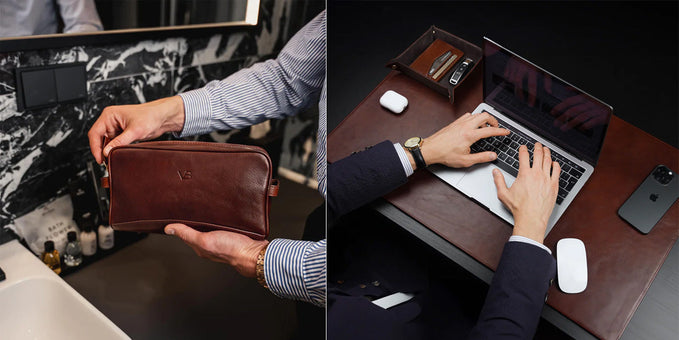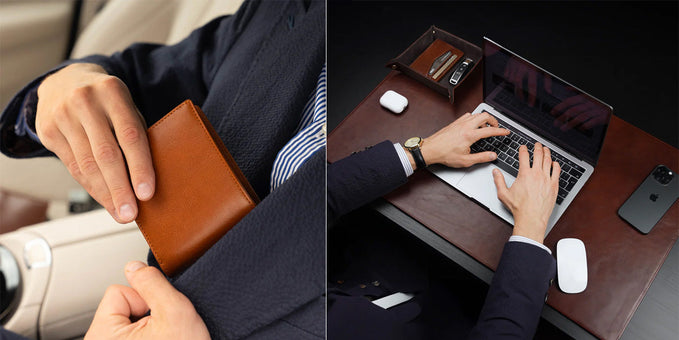Can You Put a Wallet in the Washing Machine?

If your leather wallet ended up with a stain that’s driving you crazy, you might be tempted to toss it in the washing machine.
But pause a second.
While a washing machine may seem like a fast solution, it could do more harm than good to leather, which needs special handling to stay intact and preserve its look.
Let’s explore why leather reacts the way it does to water and motion, and look at practical, effective alternatives to clean your wallet without risking its texture or shape.
Leather + Washing Machine = Broken Wallet

Excessive Moisture
Leather is a natural hide that's dyed, treated, and finished to produce the wallet you own today.
It's porous and flexible, making it absorbs moisture differently from synthetic fabrics.
When leather is completely saturated in water, its structure will change, and it becomes warped, stretched, and weakened.
Tumbled To Ruin
A washing machine subjects leather to repeated, intense impacts, applying pressure from all directions.
For structured items like a wallet, this can cause irreversible distortion.
The friction between leather and other materials during a wash cycle also risks scratches and abrasions, which are especially noticeable on dyed or textured surfaces. It also strips away the surface coating that protects your leather, making it vulnerable to cracking.
Machine washing can also compromise seams, deform the corners of the product, and damage the zippers, leaving your wallet much less functional.
Quick summary: Don't do it, it'll damage your wallet, likely irreversibly.
How To Clean a Leather Wallet Safely and Effectively

In caring for leather, the details matter. Here are step-by-step methods designed to address specific types of stains for the best possible outcome.
1. Targeted Spot Cleaning with Mild Soap
For stains like coffee, wine, or ink, a gentle approach is required.
Using harsh chemicals or standard household cleaners can lead to discoloration or drying.
Here’s how to handle specific stains safely:
-
Food or Beverage Stains: For recent spills, dab—don’t rub—with a damp cloth and a drop of pH-balanced, gentle soap like baby shampoo. Avoid excessive water, as soaking can push the stain deeper. Rubbing may also scratch the surface, leading to a patchy look.
-
Ink Stains: Ink can be tricky. Instead of alcohol-based products, which may strip color, try lightly dabbing the stain with a cloth dampened in white vinegar. This can lift ink while preserving the surface but should be used sparingly. Follow up with a leather conditioner to keep the area from drying out.
-
Grease or Oil Marks: Leather tends to absorb oils quickly. For an oil spot, sprinkle cornstarch or baking soda over the area and let it sit overnight. This absorbs the grease, making it easier to brush off. Wipe away any residue afterward and apply a conditioner if needed.
Advanced Tip: Always test any cleaning solution, even mild soap, on a small, hidden area before applying it to visible sections. Leather types can vary widely, and testing helps confirm that the finish won’t react negatively.
Avoid applying cleaner directly to the item. Instead, put a small amount on a microfiber cloth and gently work it into the stain using circular motions. Allow the leather to absorb it naturally. Over-saturating can cause patchiness, so a little goes a long way.
Stain not coming out? Perhaps it's time to buy a new wallet. Discover Von Baer's luxurious range here.
Here's an example, the Classic Bifold:
2. Conditioning After Cleaning

After cleaning leather, you've removed its natural oils, so you need to add these back in using a conditioner.
We recommend using this conditioner for leather wallets.
Rub a small amount onto a soft cloth, then gently buff it onto the leather in circular motions, concentrating on high-wear areas.
Let the wax absorb (for 30 minutes or more), then use a clean part of the cloth to polish the surface, enhancing the leather’s shine and durability.
The video below is for a bag, but the same process and logic applies to wallets:
3. Drying Properly To Prevent Shrinkage and Cracking
Even a well-cleaned wallet can suffer if not dried correctly.
Natural drying methods preserve the material’s flexibility and color, while heat or sunlight can make it brittle.
-
Avoiding Heat is Essential: Heat speeds up evaporation but strips leather of its natural oils, leading to cracking. Direct sunlight can fade dyed leather and harm the finish, especially with full-grain or vegetable-tanned varieties.
-
Proper Air Drying Tips: Place the wallet on a flat, clean surface to dry, and avoid hanging it, as gravity can cause stretching. If you’re concerned about losing shape, insert tissue paper inside to hold its form gently. Tissue paper is softer than newspaper and won’t leave ink marks.
Advanced Tip: If the leather feels stiff after drying, lightly condition it to restore suppleness. Avoid over-conditioning, as this can make the material greasy or attract dust.
Takeaway: Air-drying in a cool, controlled environment preserves both shape and texture, keeping leather soft and flexible.
Regular Conditioning for Stain Prevention and Durability

Leather is naturally prone to absorbing oils and moisture, which is why routine conditioning provides a protective layer
Conditioners not only replenish essential oils but also add a barrier against stains, making future cleanups easier and protecting the wallet over time.
We recommend using this conditioner for leather wallets.
How and When to Condition for the Best Results:
-
Regular Conditioning Schedule: Aim to condition every three to six months. However, if your wallet is frequently exposed to humid environments or heavy handling, more frequent conditioning can be beneficial.
-
How to Condition Without Overdoing It: Apply a small amount of conditioner to a soft, lint-free cloth and buff it lightly, covering all areas, including the edges, which can dry faster. Over-conditioning can lead to a greasy texture, so a little product goes a long way.
-
Choosing the Best Conditioner for Wallets: For compact items like wallets, a cream-based conditioner or beeswax balm provides a rich finish without leaving a residue. Avoid silicone-based products, which can clog leather’s pores, causing dryness over time.
Real-World Tip: If you carry your wallet in a back pocket or bag, conditioning it more often can help protect it from pressure and friction wear. This can be especially beneficial if your wallet sees frequent use throughout the day.
Takeaway: Regular conditioning creates a protective layer that guards against both stains and wear, preserving softness and enhancing durability.
We have a full post on caring for your wallet here.
Dealing With Existing Damage: Strategic Repair

Perhaps you have already put your wallet through the wash?
If so, there could be strategies you can follow to keep the damage to a minimum.
The quicker you act, the more likely it is that you'll be able to recover it.
- Instant Moisture Management: Get a clean, dry towel so you can absorb water from the surface, but don't press too hard. This can help with lifting the moisture from the wallet without damaging the leather fibers further.
- Reforming Whilst Pliable: Whilst your wallet is still damp, you can try to reshape it carefully by tucking tissues into each one of the compartments. This can replicate its usual use and reduce the risk of warping. If you leave leather unattended in this stage, it can harden into an irregular form. This can make it difficult to use later.
- Gradual Conditioning: Begin by using small amounts of conditioner and focus on damaged areas. You can then gradually build up these amounts in order to restore balance. Remember that the leather needs time to both absorb and adjust. If you apply too much conditioner too quickly, the material can become overwhelmed.
If you're unable to restore the condition of the wallet, you may wish to opt for a professional leather repair service.
These companies can use more advanced restoration techniques, including re-dyeing, reconditioning, and panel replacement.
If your DIY attempts are insufficient, professional intervention can help you achieve the right outcome.
Recommendation: Taking immediate action using precise dyeing, gradual conditioning, and reshaping can help you recover the functionality and appearance of the wallet, though professional services can be a valuable secondary option if you're faced with severe damage.
The Real Costs of Damaged Wallets

High-quality wallets are practical investments that are about so much more than just appearance.
When these wallets are presented during social engagements and business transactions, they act as reminders of your attention to detail.
Damaged or misshapen wallets can have a negative impact on the way you are perceived and impact your confidence at the same time.
Although replacing a damaged wallet may seem like a simple process, it's important to remember that heavily used wallets can become unique to their owners, with each compartment being perfectly shaped to fit specific essentials, including cards.
Leather conforms to everyday use and delivers convenience, which is challenging to replicate.
Replacing a wallet that has adapted to your daily routine can be time-consuming as you'll seek one that meets your stylistic and functional requirements. It will also need to be broken in.
Instead of risking damage by opting for a quick fix, it's wise to preserve the quality of your existing wallet so it serves you well on a long-term basis, not only in terms of function but in the way it reflects your style, too.
We have a series of related guides that may help you:
Ensuring Longevity: Investing in Leather Care
Taking the time to maintain your wallet can be a valuable investment. Let's look at ways to incorporate effective care routines into life with your beloved wallet.
- Protective Treatments: Waterproof sprays from reputable brands that are specifically designed for leather can protect against rain and spills. However, they do need to be reapplied every few months if they are to remain effective. It's best to apply such treatments during changes in the seasons when weather fluctuations occur regularly.
- Habitual Maintenance: Simple practices, like removing cards and receipts that add bulk, help keep wallet seams intact and prevent long-term damage. These easy steps maintain a streamlined wallet and preserve its structure over time.
- Regular Conditioning: Maintain your wallet's condition by cleaning and conditioning it every few months. This routine preserves flexibility, prevents cracking, and extends its lifespan, keeping it looking professional.
There's no need for leather care to feel like a chore. It can maximize your investment and ensure that it serves you well for years and reflects your professional standards every day.
Final tip: Carry out consistent care routines like conditioning and waterproofing to protect the longevity and quality of your wallet so it remains a stylish and dependable accessory for many years to come.

Author: Igor Monte
Igor Monte is the co-founder of Von Baer. He's an expert in all things premium leather, from being an end-user right up to the design and manufacturing process. His inside knowledge will help you choose the best leather product for you.
We strive for the highest editorial standards, and to only publish accurate information on our website.
Leave a Comment
Your email address will not be published.







